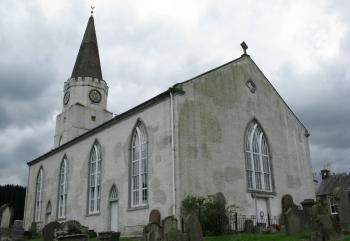- Navigation:
- Back to the Corpus index page
- RSS
Comrie Parish Church
Comrie Church, exterior, from south east
- Dedication: unknown/St Kessog
- Diocese of Dunblane
- County of Perthshire
- Perth and Kinross Council
- NN 7726 2203
Summary description
The present parish church, which is believed to occupy the site of its predecessor, is a large rectangular building with an imposing steeple at its west end. Nothing visible remains of its predecessor.
Historical outline
Dedication: unknown/St Kessog(1)
Nothing is known of the pre-thirteenth-century development of this parish. The earliest surviving reference to it is in an agreement of 1237, whereby Bishop Clement of Dunblane received one quarter of the parish revenues to augment the slender resources of his see.(2) It is possible that the parsonage revenues had been appropriated at an early date to provide for a prebend in the cathedral of Dunblane, but the earliest reference to this arrangement dates from 1534/5 and it is apparently still as a free parsonage that the church was taxed in 1275.(3) The prebend was held at the Reformation by Mr Alexander Chisholm, but 40 shillings from the parsonage revenues was allocated for the maintenance of one of the nine chaplains in the choir of Dunblane cathedral.(4) At the Reformation, the incumbent of the vicarage, John Sinclair, also held the provostry of the collegiate chapel of Innerpeffray, but there is no evidence that it had been appropriated as the provost’s prebend and the arrangement appears to have been a simple case of pluralism on Sinclair’s part.(5) In 1569-72, William Drummond was serving as minister for the parishes of Crieff, Strageath, Comrie, Monzievaird and Tullicheddill.(6)
It has in the past been suggested that the western portion of Comrie parish had been a separate parish with its church at Dundurn, and that the two had been united in the sixteenth century.(7) There is, however, no evidence for the existence of a separate parish of Dundurn at any date. While the burial ground at Dundurn does appear to occupy the site of an earlier enclosure, and sculptural remains from the site point to an Early Historic date for its establishment, there is no evidence that any religious building on this site ever held parochial status.(8) It is likely that the site at Dundurn was a dependent chapel serving the western end of the parish of Comrie, possibly with cult associations with St Fillan. There is no record of any endowed chaplainry associated with the chapel at the time of the Reformation.
Notes
1. Cockburn, Medieval Bishops of Dunblane, 9.
2. Theiner, Vetera Monumenta, no xci.
3. SHS Misc, vi, 54, 71; RSS, iv, no 2914.
4. Kirk (ed.), Book of Assumptions, 312, 343.
5. Cowan, Parishes, 35; Donaldson (ed.), Thirds of Benefices, 15; Kirk (ed.), Book of Assumptions, 334.
6. Donaldson (ed.), Thirds of Benefices, 250.
8. Alcock and Alcock, ‘Dundurn’, 196; N.M. Robertson, ‘Undescribed cross-slab discovered at Dundurn’, Pictish Arts Society Journal, iii (1993), 9-12.
Architectural description
The author of the Statistical Account in 1792-3 complained that the church was too small and that it was in poor repair. It was rebuilt to the designs of John Stewart in 1803-5, and has come to be known as the White Church on account of its harled and painted exterior. The graveyard to the south and east of the church was evidently in use before the present church was built, with one memorial dated to 1682. It is assumed that the church occupies the site of its predecessor; Roy’s map of 1793 appears to show that predecessor as having had a north aisle, and to have been in a position that would have located it to the east and south within the area of the present building. However, while limited excavations in advance of adapting the church as a community centre in 1999 showed that the later church had encroached on the area of the existing graveyard, no evidence of the earlier church was found at that time.
Bibliography
Alcock, L., Alcock, E.A. and Driscoll, S., 1989, ‘Reconaissance excavations on early historic fortifications and other royal sites in Scotland, 3: Dundurn’, Proceedings of the Society of Antiquaries of Scotland, cxix, pp. 189-226 at 196.
Cachart, R. and Cox, A., 2001, ‘Archaeological excavation at the White Church, Comrie’, Tayside and Fife Archaeological Journal, vii, 118-28.
Cockburn, J.H., 1959, The Mediaeval Bishops of Dunblane and their Church, Edinburgh, 9.
Cowan, I.B., 1967, The parishes of medieval Scotland, (Scottish Record Society), Edinburgh, 34-5.
Donaldson, G., 1949, Accounts of the collectors of thirds of benefices, (Scottish History Society), Edinburgh, 15, 250.
Dunlop, A.I., 1939, ‘Bagimond’s Roll, statement of the tenths of the kingdom of Scotland’ Miscellany of the Scottish History Society, vi, 1-77, at 54, 71.
Gifford, J., 2007, The Buildings of Scotland, Perth and Kinross, New Haven and London, 278.
Hay, G., 1957, The architecture of Scottish post-Reformation churches, Oxford, 116-7.
Kirk, J., 1995, The books of assumption of the thirds of benefices, (British Academy) Oxford, 312, 334, 343.
New Statistical Account of Scotland, 1845, Edinburgh and London, vol. 10, 591.
Registrum Secreti Sigilli Regum Scotorum, 1908-82, ed. J.M. Thomson et al., Edinburgh, iv, no 2914.
Robertson, N.M., 1993, ‘An undescribed cross-slab discovered at Dundurn’, Pictish Arts Society Journal, iii, 9-12.
Roy, W., 1747-55, The military survey of Scotland, reprinted Edinburgh, 2007, pl. 76.
Royal Commission on the Ancient and Historical Monuments of Scotland, Canmore database.
Scott, H., 1922, Fasti Ecclesiae Scoticanae, iv, Edinburgh, 268.
Statistical Account of Scotland, 1791-9, ed. J. Sinclair, Edinburgh, xi (1794), 184
Vetera Monumenta Hibernorum et Scotorum Illustrantia, 1864, ed. A. Theiner, Rome, no xci.
Map
Images
Click on any thumbnail to open the image gallery and slideshow.






